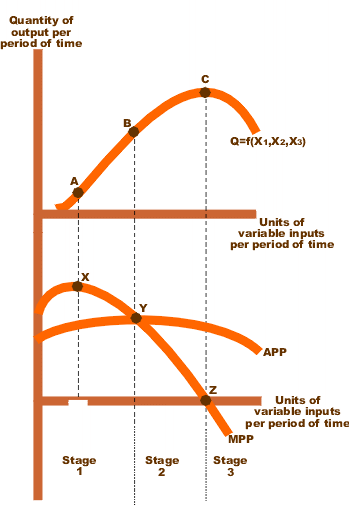Obviously, the factors of production (land, labor, capital, and entrepreneur) affect production, hence the name. However, this vague qualitative claim can’t tickle our economic bone. We need more quantifiable answers. And the production function serves the purpose. Let us take a look at the Cobb-Douglas Production Function.
Browse more Topics under Theory Of Production And Cost
- An Introduction to Financial Statements
- Distinction between Capital Revenue and Capital Expenditure
- Operating Profit
- Trading and Profit and Loss Account
- Balance Sheet and Opening Entry
- Stakeholders and their Information Requirement
- Depreciation, Bad Debts and Provision for Bad and Doubtful Debts
- Need for Adjustment, Closing Stock and Outstanding Expenses
- Prepaid Expenses, Accrued Income and Income Received in Advanced
- Provision for Discount on Debtors, Managers Commission and Interest on Capital
- Manufacturing Account
Production Function
As discussed, the production function provides a quantitative perception of the relationship between the inputs and outputs. The inputs are the various factors of production- land, labour, capital, and enterprise whereas the outputs are the goods and services.
To put it differently, the production function can provide us with the maximum goods and services that we can produce using a given amount of inputs. Further, it can also help us in determining the inputs we require to achieve a minimum level of production. Note that a production function is defined for a given state of technology.
According to Richard H.Lefthich: The term production function is applicable to the physical relationship between a firm’s input of resources and its output of goods or services per unit of time leaving prices aside.
Moving away from complex definitions, we can say that the production function is a catalogue of output possibilities. Quantitatively, we can express the production function in the form of an equation in which the output is a dependent variable. Further, this output is a function of the inputs which are the independent variables. The equation is as follows:
q= f (a, b, c……, n)
Here ‘q’ stands for the rate of output of the given commodity and a, b, c, d…..n are the different inputs used per unit of time.
Cobb-Douglas Production Function
The Cobb-Douglas production function, named after Paul H. Douglas and C.W. Cobb, is a famous statistical production function. It was derived to study the whole of American manufacturing industries. The Cobb-Douglas production function is as follows:
Q= KLª[C^(l-a)]
Here Q is output, L is the quantity of labour, C is the quantity of capital, l and a are positive constants. This study led to the conclusion that labour contributes about 3/4th and capital about 1/4th of the increase in manufacturing production.

Short Run Vs. Long Run
Note that we can look at the production function through two-time frames- short run and long run. The short run is a short interval of time, in which we can change only the variable factors of production.
To point out, these variable factors are the ones which we can change over a small period of time, as the number of labour, raw material, fuel, power, etc. Symbolically, Q= T(K, L). Further, we do this with the help of the law of variable proportions.
On the other hand, the long run is a relatively much longer period of time. Obviously, in the long run, we can change all the factors of production i.e. both fixed and variable factors.
Hence, in the long run, we can change the factory size, techniques of production, machinery, to the number of labours, power, fuel and so on.
Thus the production function takes different forms according to the two-time frames. Evidently, we study production function with respect to two different time frames. The long-run production function is the subject matter of the law of returns to scale.
Assumptions of Production Function
The various assumptions of production function are:
- It is related to a particular unit of time.
- The technical knowledge during that time period remains constant.
- The producer uses the best technique available.
Solved Example on Production Function
Q: Which of the following is not an assumption of the production function?
- The technique used depends solely on the producer’s knowledge.
- Technical knowledge may or may not develop.
- It is related to a particular unit of time.
- Both a and b
Ans: The correct option is D.






Leave a Reply